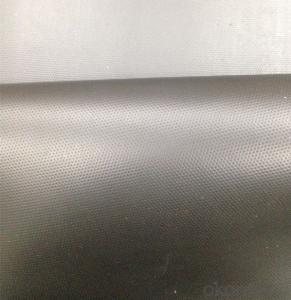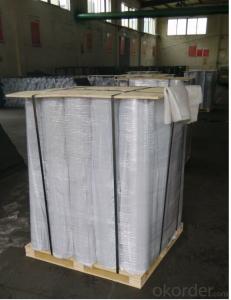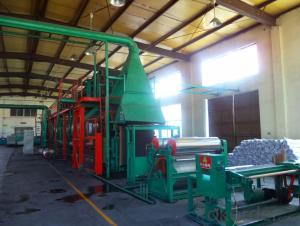EPDM Rubber Waterproof Membrane NO.1 CMAX
- Loading Port:
- Qingdao
- Payment Terms:
- TT OR LC
- Min Order Qty:
- 3500 m²
- Supply Capability:
- 200000 m²/month
OKorder Service Pledge
OKorder Financial Service
You Might Also Like
EPDM Rubber Waterproof Membrane
Product Instruction:
EPDM waterproof membrane is made from ternary ethylene-propylene rubber,which is designed for waterproofing of exposed and non-exposed applications. EPDM waterproof membrane is of high elasticity among high polymer waterproof materials and becomes a world-popular waterproofing material.
CNBM own the wold-advanced equipment of cold feeding extrusion and continuous vulcanization technology. With the best performance among high polymer waterproof materials, EPDM is of exceptional elasticity and will not split or cracked under normal building movement.
Product Features:
-Excellent weather-ability, durability and size stability
-Good adaptability to high and low temperature, UV resistant and anti-corrosion
-High tensile strength and good elongation, accommodating to structure movement
-Easy installation, solid joint, and mo environmental pollution
-Good rooting penetration resistance
-Service life up to 50 years
Applications:
-Roof, basement, tunnel, pond liner, dam
-Industrial and civil building waterproofing
-Geosynthetic liner for fish ponds, swimming pools, channels, irrigation system
-Especially suitable for projects with high requirement in durability, anti-corrosion and deformation
Specifications:
-Width of roll: 1.2m, 2m, 4m
-Length of roll: 20m, 30m or customized
-Thickness of membrane: 1.2mm, 1.5mm, 2mm
-Type: vulcanized EPDM or welding EPDM
-Application: roof, basement, pond, lake, swimming pool, steel structure roofing, underground, tunnel, etc
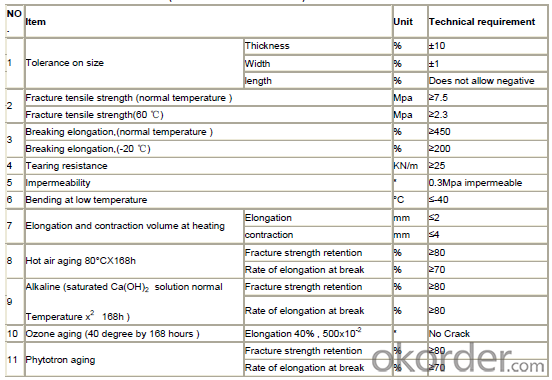
FAQ:
1. Is your EPDM waterproof membrane the real rubber?
Yes, our EPDM membrane is made from top quality rubber, which is imported from America. We support samples for testing, or testing in our factory.
2. How's your products quality?
Our EPDM is with the top quality at home and abroad. Our quality is much higher than Chinese standard. Our product is widely used in Chinese Central government projects. And it's also accpted by customers all over the world, such as EU, USA, Astrulia, etc.
3. What's the service life of your EPDM membrane?
The service life of our EPDM membrane is more than 50 years.
4.What's your MOQ?
Our MOQ is 3000M2.
5. What's your product ability of EPDM membrane?
We own the largest EPDM production line in China. Our product ability of EPDM membrane reaches 2 million square meter per year.
Photos:
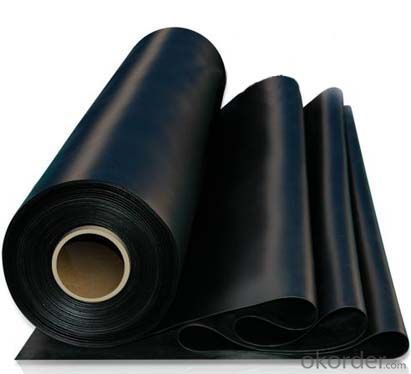
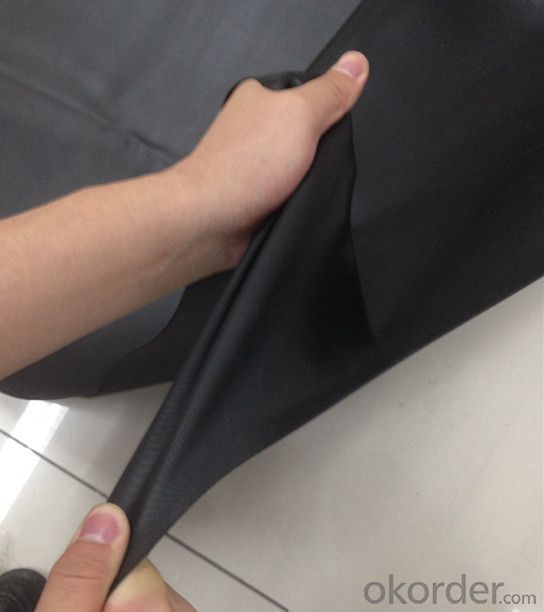


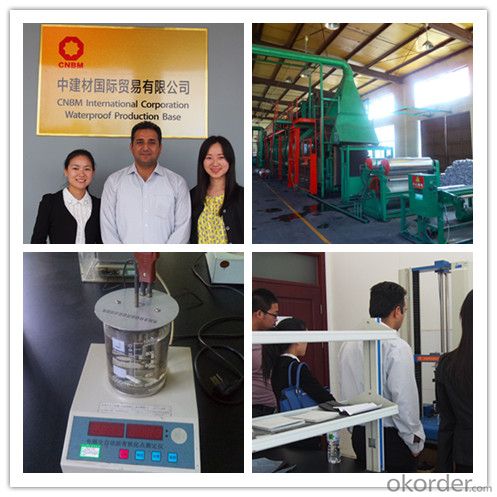
- Q:Are there any specific considerations for installing a waterproofing membrane on concrete surfaces?
- Yes, there are several specific considerations for installing a waterproofing membrane on concrete surfaces. Firstly, it is important to ensure that the concrete surface is clean, dry, and free from any loose materials, oil, grease, or other contaminants. Any dirt or debris on the surface can prevent proper adhesion of the waterproofing membrane, compromising its effectiveness. Secondly, it is crucial to inspect the concrete surface for any cracks, spalling, or other damage. These defects should be repaired prior to installing the waterproofing membrane, as they can allow water to penetrate through the membrane and compromise its ability to protect the concrete. Additionally, the type of waterproofing membrane chosen should be suitable for the specific conditions and requirements of the project. There are various types of membranes available, such as sheet membranes, liquid-applied membranes, or cementitious coatings. Each type has different application methods, durability, flexibility, and resistance to various substances, so it is important to select the appropriate membrane for the specific concrete surface and its intended use. Furthermore, the installation of the waterproofing membrane should be carried out in accordance with the manufacturer's instructions. This includes applying the membrane at the recommended thickness, ensuring proper overlap and adhesion of the membrane seams, and using any recommended primers or adhesives. Lastly, it is important to consider the long-term maintenance and durability of the waterproofing membrane. Regular inspections, maintenance, and repairs should be conducted to ensure the membrane remains intact and effective in preventing water penetration.
- Q:Are waterproofing membranes effective in preventing water damage?
- Waterproofing membranes prove highly efficient in the prevention of water damage. Crafted with the intention of creating a barrier that hinders the infiltration of water and the penetration of moisture into surfaces like roofs, basements, and foundations, these membranes significantly reduce the risk of water damage arising from leaks, seepage, or condensation. Typically composed of durable materials such as rubber, PVC, or bitumen, waterproofing membranes possess a high resistance to water and moisture. Various application methods, including spraying, rolling, or adhering with a special adhesive, ensure these membranes secure surfaces with a seamless and watertight seal, effectively blocking the seepage of water. Furthermore, waterproofing membranes offer additional advantages beyond their water damage prevention capabilities. They contribute to enhanced energy efficiency by reducing heat loss or gain and safeguard against the growth of mold and mildew. Moreover, these membranes extend the lifespan of protected surfaces by countering water-related deterioration, such as corrosion or rot. It is crucial to acknowledge that the efficacy of waterproofing membranes relies on proper installation and regular maintenance. Any flaws or damage in the membrane can compromise its ability to prevent water damage. Therefore, engaging professional contractors experienced in waterproofing is essential to guarantee correct application and regular inspection for signs of wear or damage. Overall, waterproofing membranes represent a dependable and efficient solution for averting water damage. They offer a long-lasting and sturdy defense against water infiltration, preserving the structural integrity of buildings and avoiding costly repairs stemming from water-related issues.
- Q:Can a waterproofing membrane be used for a crawl space?
- Indeed, a crawl space can benefit from the application of a waterproofing membrane. Given their vulnerability to moisture and water infiltration, crawl spaces can experience a range of problems including the growth of mold, structural deterioration, and unpleasant odors. By employing a waterproofing membrane, the infiltration of water and moisture into the crawl space can be effectively impeded. Typically, this membrane is affixed to the walls and floors of the crawl space, forming a secure seal that prevents any water from seeping through. Consequently, this membrane serves as an exceptional remedy for the waterproofing of crawl spaces. Furthermore, certain waterproofing membranes possess antimicrobial properties, thereby further diminishing the likelihood of mold and mildew growth within the crawl space.
- Q:Can a waterproofing membrane be used for bridges and overpasses?
- Yes, a waterproofing membrane can be used for bridges and overpasses. Waterproofing membranes are commonly used in infrastructure projects to protect the structures from water damage and extend their lifespan. They create a barrier against moisture, preventing water infiltration and protecting the underlying materials from corrosion and deterioration. By applying a waterproofing membrane to bridges and overpasses, it helps ensure their durability and structural integrity.
- Q:Can waterproofing membranes be used on utility vaults?
- Utility vaults, which are commonly found underground and contain vital utility equipment like electrical transformers, water meters, and communication systems, can benefit from the use of waterproofing membranes. These structures are vulnerable to water infiltration, which can harm the equipment and disrupt its operation. To prevent water from entering utility vaults, waterproofing membranes are often employed. These membranes, typically composed of robust materials like rubber, PVC, or modified bitumen, form an impenetrable barrier against moisture. Applied to the walls and floors of the vault, they establish a tight seal that wards off any water seepage. By employing waterproofing membranes on utility vaults, the risk of water damage is significantly diminished. This safeguard ensures that the equipment housed within remains functional and undamaged for an extended period. Additionally, these membranes offer protection against other potential issues, such as leaks, corrosion, and chemical damage. However, it is crucial to note that the proper preparation of the surface and correct installation techniques are essential for a successful and enduring waterproofing system on utility vaults. Therefore, it is advisable to consult a professional waterproofing contractor with experience in working on utility vaults to achieve optimal results.
- Q:Can a waterproofing membrane be used in new construction?
- A waterproofing membrane is capable of being utilized in new construction. In fact, it is frequently advised to incorporate a waterproofing membrane during the construction phase to furnish an extra layer of safeguard against water harm. Typically, waterproofing membranes are administered to the external foundation walls and basement floors to obstruct water infiltration and construct a barrier against moisture. This can effectively avert predicaments like leaks, mold, and structural damage in the long run. Furthermore, waterproofing membranes can also be employed in other areas of a new construction project, such as roofs, balconies, and bathrooms, to guarantee long-lasting waterproofing protection. On the whole, the utilization of a waterproofing membrane in new construction can contribute to the extension of the building's lifespan and instill peace of mind for its occupants.
- Q:Can a waterproofing membrane reduce noise transmission?
- Yes, a waterproofing membrane can reduce noise transmission.
- Q:Can a waterproofing membrane be used for roof gardens?
- Yes, a waterproofing membrane can be used for roof gardens. It is a common practice to use waterproofing membranes as a protective layer beneath the soil and plants in roof garden installations. These membranes help prevent water leakage into the building below and ensure the longevity of the roof garden system.
- Q:Can a waterproofing membrane be used on chrome surfaces?
- While a waterproofing membrane can potentially be applied to chrome surfaces, it may not be essential or advisable. Chrome surfaces usually possess natural resistance to water and moisture thanks to their inherent properties and protective coatings. These coatings effectively shield against corrosion and prevent water-related harm. Consequently, adding an extra layer of waterproofing membrane onto a chrome surface might not yield any additional advantages and could potentially compromise the chrome's appearance and functionality. To ensure the appropriate treatment for chrome surfaces, it is always wise to consult the manufacturer or seek guidance from a professional in the field.
- Q:Can waterproofing membranes be used on concrete countertops?
- Yes, waterproofing membranes can be used on concrete countertops. These membranes are designed to create a barrier that prevents water from seeping into the concrete, protecting it from damage and increasing its lifespan.
1. Manufacturer Overview |
|
|---|---|
| Location | |
| Year Established | |
| Annual Output Value | |
| Main Markets | |
| Company Certifications | |
2. Manufacturer Certificates |
|
|---|---|
| a) Certification Name | |
| Range | |
| Reference | |
| Validity Period | |
3. Manufacturer Capability |
|
|---|---|
| a)Trade Capacity | |
| Nearest Port | |
| Export Percentage | |
| No.of Employees in Trade Department | |
| Language Spoken: | |
| b)Factory Information | |
| Factory Size: | |
| No. of Production Lines | |
| Contract Manufacturing | |
| Product Price Range | |
Send your message to us
EPDM Rubber Waterproof Membrane NO.1 CMAX
- Loading Port:
- Qingdao
- Payment Terms:
- TT OR LC
- Min Order Qty:
- 3500 m²
- Supply Capability:
- 200000 m²/month
OKorder Service Pledge
OKorder Financial Service
Similar products
New products
Hot products
Related keywords

